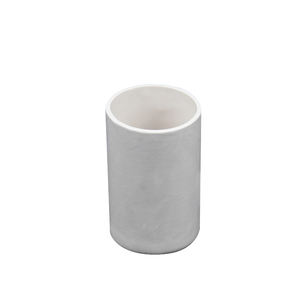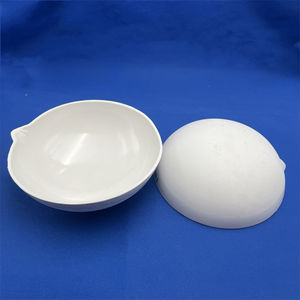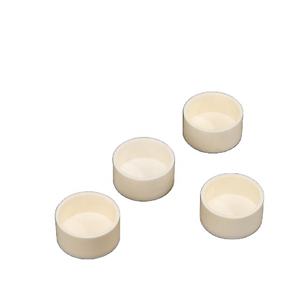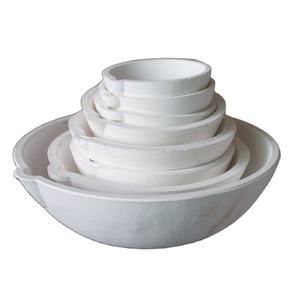Professional industry ceramic supplier, silicon nitride, silicon carbide, aluminum nitride and any other kinds of ceramics.
PRODUCT PARAMETERS
Description
Overview of Ceramic Crucible Melting Gold Silver Copper Platinum Palladium Glass Corrosion Resistance Quartz Crucibles Cup Jewelry Tools
Ceramic Crucible Melting Gold Silver Copper Platinum Palladium Glass Corrosion Resistance Quartz Crucibles Cup Jewelry Tools are a unique class of materials manufactured by fusing high-purity quartz crystal into a non-crystalline, vitrified form. This process results in a ceramic with an exceptionally low and predictable thermal expansion coefficient, making it supremely resistant to thermal shock. Its outstanding optical, thermal, and electrical properties make it indispensable in high-temperature viewing windows, semiconductor processing, precision instrumentation, and aerospace applications.
Features of Ceramic Crucible Melting Gold Silver Copper Platinum Palladium Glass Corrosion Resistance Quartz Crucibles Cup Jewelry Tools
-
Exceptional Thermal Shock Resistance: Its near-zero thermal expansion coefficient allows it to withstand extreme and rapid temperature changes without cracking.
-
High Purity & Chemical Stability: Excellent resistance to corrosion from acids and molten metals, ensuring performance in aggressive environments.
-
High Service Temperature: Can be used continuously at high temperatures while maintaining its structural integrity.
-
Excellent Optical Properties: Offers high transmission from the ultraviolet to the infrared spectrum, ideal for lenses, windows, and optical substrates.
-
Low Thermal Conductivity: Provides effective thermal insulation.
-
Superior Electrical Insulation: Maintains high electrical resistivity and low dielectric loss at elevated temperatures.
Specifications of Ceramic Crucible Melting Gold Silver Copper Platinum Palladium Glass Corrosion Resistance Quartz Crucibles Cup Jewelry Tools
Ceramic crucibles melt precious metals like gold, silver, copper, platinum, and palladium. They also work for glass. These crucibles are made from quartz ceramic. Quartz ceramic is very strong against heat. It withstands temperatures up to 1600 degrees Celsius. That’s very hot. This high heat resistance is crucial for melting metals completely.
Thermal shock resistance is another key feature. These crucibles don’t crack easily when heated fast or cooled fast. Sudden temperature changes are common in melting work. This durability is important. It saves money over time. You don’t need to replace them often.
Chemical resistance is excellent. The quartz ceramic fights off corrosion. Acids and alkalis don’t damage it easily. Molten glass is also very corrosive. These crucibles handle that well. This resistance keeps your melt pure. Contamination is a big problem. These crucibles help avoid it.
These crucibles come in many sizes. Small sizes are good for jewelry makers. They are perfect for testing small amounts of metal. Larger sizes suit bigger melting jobs in labs or foundries. Different shapes are available too. Common shapes are cups and standard crucible forms. The shape depends on your furnace or torch setup. The ceramic material is dense. It doesn’t soak up the molten metal. This makes pouring cleaner. Cleanup is easier after use. You get more usable metal back.
Applications of Ceramic Crucible Melting Gold Silver Copper Platinum Palladium Glass Corrosion Resistance Quartz Crucibles Cup Jewelry Tools
Ceramic crucibles handle extreme heat safely. They melt precious metals like gold, silver, copper, platinum, plus palladium. These crucibles resist very high temperatures without breaking. This is vital for metal melting. Quartz crucibles offer excellent options. They provide superb resistance to heat shock. Sudden temperature changes rarely crack them. This reliability matters for consistent results.
Corrosion resistance is another key strength. Harsh chemicals found in metal alloys or fluxes don’t easily damage these crucibles. Glass melting also uses these crucibles. The material withstands molten glass’s corrosive nature. Crucibles maintain purity. They prevent unwanted materials from contaminating the melt. Clean metal or glass comes out every time. This purity is essential for quality work.
Jewelers and metalworkers depend on these tools daily. Crucibles hold molten material securely. They allow safe pouring into molds. Their durability means long service life. This saves money over time. Labs use them for precise experiments. Foundries rely on them for larger scale operations. The crucible material must be inert. It shouldn’t react with the molten contents. Ceramic and quartz achieve this well. Different shapes and sizes exist. Small cups suit jewelry repairs. Larger crucibles handle bigger batches. Selecting the right size is straightforward. Proper heating techniques are important. Crucibles tolerate intense furnace heat. They also work over direct flames. Handling them requires care when hot. Good tongs are necessary. Letting them cool slowly prevents stress cracks. Investing in quality crucibles pays off. They are fundamental tools for melting.
Company Profile
Tanki New Materials Co.Ltd. focus on the research and development, production and sales of ceramic products, serving the electronics, ceramics, chemical and other industries. Since its establishment in 2015, the company has been committed to providing customers with the best products and services, and has become a leader in the industry through continuous technological innovation and strict quality management.
Our products includes but not limited to Aerogel, Aluminum Nitride, Aluminum Oxide, Boron Carbide, Boron Nitride, Ceramic Crucible, Ceramic Fiber, Quartz Product, Refractory Material, Silicon Carbide, Silicon Nitride, ect. please feel free to contact us.

Payment Methods
T/T, Western Union, Paypal, Credit Card etc.
Shipment Methods
By air, by sea, by express, as customers request.
5 FAQs of Ceramic Crucible Melting Gold Silver Copper Platinum Palladium Glass Corrosion Resistance Quartz Crucibles Cup Jewelry Tools
Ceramic Crucible FAQ: Melting Precious Metals & Glass
What are these crucibles made of?
These crucibles are high-purity alumina ceramic. This material handles extreme heat well. Quartz crucibles are another option. Quartz is great for glass. Choose based on your material.
How hot can these crucibles get?
They withstand very high temperatures. Standard alumina crucibles handle 1800°C (3272°F) easily. This is hot enough for gold, silver, copper, platinum, palladium. It’s hot enough for most glass work. Always check the specific product rating first.
Will acids or molten metal damage the crucible?
Alumina ceramic resists chemical attack well. It handles molten precious metals safely. It resists corrosion from many fluxes. Avoid strong alkalis or hydrofluoric acid. These can damage the surface. Quartz crucibles resist acid corrosion better. Pick the right type for your chemicals.
Can I reuse these crucibles?
Yes, you can reuse them multiple times. They are very durable. Inspect each crucible carefully before reuse. Look for cracks, deep pits, or significant thinning. Discard any damaged crucible. Damage can lead to failure and spills. Handle with care every time.
What size crucible do I need?
Choose based on the amount of material you melt. Crucibles come in many sizes. Measure capacity in milliliters or ounces. Never fill a crucible completely full. Leave space at the top. Molten metal expands. Overfilling causes spills and danger. Pick a size giving you enough headroom.
REQUEST A QUOTE
RELATED PRODUCTS

High Temperature Resistant Quartz Glass Plate for Vacuum Furnace Applications

CNC Honed Terrazzo Porcelain Slab Marble Look Calacatta Quartz Stone Slab Cutting Machine

Customized Half Round Quartz Glass Rod Optical Quartz Glass Cylindrical Rod Lens Quartz Half Rods

Factory Custom Heat Resistant Alumina Ceramic Crucible Large Silica Opaque Quartz Crucible

Professionally Produced Transparent Polishing Silica Quartz Rod Half Round Quartz Glass Rod



